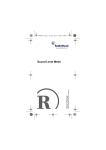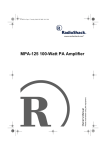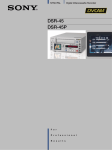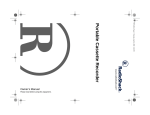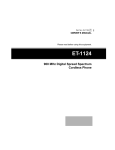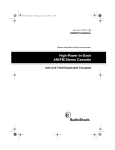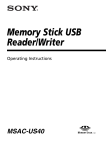Download Radio Shack 04A00 Owner`s manual
Transcript
250-Watt Stereo PA Amplifier Owner’s Manual Please read before using this equipment. ˆ Contents Contents .................................................................................................................................. 2 Features .................................................................................................................................. 3 Preparation ............................................................................................................................. Presetting the Controls ...................................................................................................... Presetting Audio Input Devices .................................................................................. Presetting the Amplifier .............................................................................................. Mounting the Amplifier ...................................................................................................... Placing the Speakers ........................................................................................................ 4 4 4 4 4 4 Connections ............................................................................................................................ Connecting an Input Source .............................................................................................. Unbridged Connection ............................................................................................... Bridged Connection ................................................................................................... Grounding the Input Source .............................................................................................. Connecting Speakers ........................................................................................................ Preparing the Speaker Wires ..................................................................................... Unbridged Connection ............................................................................................... Bridged Connection ................................................................................................... Using the Switched AC Outlet ........................................................................................... Connecting Power ............................................................................................................. 5 5 5 5 6 6 6 6 7 7 7 Using Your Amplifier .............................................................................................................. Using the Meters/METER RANGE .................................................................................... CLIP Indicator ................................................................................................................... Using SPEAKER A/B ........................................................................................................ Monitoring the Sound Sources .......................................................................................... Listening Safely ......................................................................................................... 8 8 8 8 8 9 Care ......................................................................................................................................... 9 Replacing the Fuse ........................................................................................................... 9 The FCC Wants You to Know .............................................................................................. 10 Specifications ....................................................................................................................... 11 © 1998, 2000 Tandy Corporation. All Rights Reserved. RadioShack is a registered trademark used by Tandy Corporation. 2 Contents ˆ Features Your Public Address Amplifier gives you the versatility and power you need in a professional sound system. Its wide frequency response easily handles amplification of voice and music. Use it in meeting halls and auditoriums, at sports events, in schools, and in the office for paging systems — anywhere you need to deliver special announcements with excellent sound. The amplifier (if bridged) produces up to 350 watts of clean, powerful sound with minimum distortion. Your amplifier includes these features: Input Jacks —let you connect a variety of audio input sources for music and special effects. A/B SPEAKER Switches — let you select the speakers you want to use with the amplifier. STEREO/MONO Switch — lets you select the output type; stereo or mono (bridged). Binding Post Terminals — let you easily connect wires directly to the amplifier. Switched AC Outlet — lets you power other devices by plugging them into the back of the amplifier. 10–50000 Hz Frequency Response Built-In Cooling Fan — helps protect the amplifier by reducing its internal temperature. WARNING: To reduce the risk of fire or shock hazard, do not expose this product to rain or moisture. Two Mounting Options — you can mount the amplifier in a standard-sized audio equipment rack or on a desk, shelf, or table. 2 Lighted VU Meters — measure the amplifier’s output for each channel in decibels. Left and Right Output Level Gain Controls — let you adjust the overall sound level on the left and right channels. CAUTION RISK OF ELECTRIC SHOCK. DO NOT OPEN. CAUTION: TO REDUCE THE RISK OF ELECTRIC SHOCK, DO NOT REMOVE COVER OR BACK. NO USER-SERVICEABLE PARTS INSIDE. REFER SERVICING TO QUALIFIED PERSONNEL. Clipping Indicator — lights if a sound source signal overdrives the amplifier. This symbol is intended to alert you to the presence of uninsulated dangerous voltage within the product’s enclosure that might be of sufficient magnitude to constitute a risk of electric shock. Do not open the product’s case. Phones Jack — lets you connect headphones so you can listen privately. Bridging Capability — you can combine the amplifier’s two channels and use the amplifier with only one channel, producing a total of 350 watts. Meter Range Select Switch — lets you control the meter’s sensitivity. Features ! ! This symbol is intended to inform you that important operating and maintenance instructions are included in the literature accompanying this product. 3 ˆ Preparation PRESETTING THE CONTROLS MOUNTING THE AMPLIFIER Before you begin making connections or using your amplifier, preset the audio input source’s and the amplifier’s controls to avoid overdriving a channel or producing sudden unexpected loud sounds. Warning: To prevent possible hearing loss, set the audio input device’s and amplifier’s controls as indicated in the following sections. After you turn on the amplifier or change the program source, adjust the controls to a comfortable listening level. You can mount the amplifier in a standardsized audio equipment rack or on a desk, shelf, or table. Before you use your amplifier, be sure you place it in a location with adequate ventilation. Do not put it on thick carpeting (which can restrict air flow) or near a heat source such as a heat vent or radiator (which can cause it to overheat). To mount the amplifier on a standard-sized audio equipment rack, drive and tightly secure mounting screws (not supplied) through the mounting holes. Presetting Audio Input Devices PLACING THE SPEAKERS Always set the power control for an audio mixer or preamplifier you connect to the amplifier to OFF. Speaker placement depends on your room’s size and arrangement. We recommend you play a wide-range recording and experiment with speaker placement until you find the locations that result in the best sound. For the best results, point the speakers toward the audience (especially if the speakers are far apart) so the coverage areas overlap to prevent dead spots (areas not covered by the speakers’ sound). Position the speakers slightly above the level of the listeners’ heads (see “Connecting Speakers” on Page 6). Presetting the Amplifier Set the amplifier’s controls as follows: Control 4 Setting POWER Out SPEAKER A/B Out LEFT and RIGHT MIN METER RANGE Out Preparation The following drawings show recommended speaker placements for typical, narrow, and wide sound coverage. Typical Coverage Narrow Coverage (single speaker) Wide Area Coverage (two speakers) ˆ Connections CONNECTING AN INPUT SOURCE is off and the AC power cord is not plugged in. You can connect a component such as an audio mixer or preamplifier to the inputs on the back of your amplifier. Each input (labeled INPUT and INPUT MONO) has a balanced and unbalanced jack. You need a shielded cable with a 1/4-inch (6.35-mm) phono plug to connect to an unbalanced jack or a cable with a phono-type plug to connect to a balanced jack. To prevent hum and other noise, use low-capacitance shielded cable. Your local RadioShack store carries a wide selection of audio components, parts, and cables. Unbridged Connection If you are connecting more than one speaker on the same channel (unbridged connection), connect your audio mixer’s or preamplifier’s left and right output jacks to the INPUT R and INPUT L jacks on the back of the amplifier. Then, make sure STEREO/MONO on the back of the amplifier is set to STEREO. Note: If you are using the MIC level inputs, you must connect an audio mixer or pre-amplifier to this amplifier. Bridged Connection Cautions: • You can connect audio mixers or preamplifiers to either the balanced or unbalanced jacks. Do not connect input sources to both jacks at the same time. If you are connecting high-power speakers that can handle a power output of 350 watts (bridged connection), connect your audio mixer’s or preamplifier’s output jack to the INPUT MONO or INPUT L jack on the back of the • Before you make any connections, be sure POWER on the front of the amplifier Connections 5 amplifier. Then, make sure STEREO/MONO on the back of the amplifier is set to MONO. speakers, use this table to determine the wire length and choose the appropriate gauge. Wire Length GROUNDING THE INPUT SOURCE To avoid a low frequency hum, connect your audio mixer’s or preamplifier’s ground wire (usually black or green) to the GND terminal on the back of the amplifier. Wire Gauge 25 feet or less 18 gauge Over 25 feet 16 gauge To prepare the speaker wire, remove about 1 inch of insulation from the end of the speaker wire you are connecting to the amplifier. Then twist the exposed wire to secure all of the wire strands. Split strands about 4” CONNECTING SPEAKERS Wire Strands 1" You can connect one or more 4-, 8-, or 16ohm speakers to the amplifier. You can also bridge the amplifier’s channels. The amplifier has two channels: A and B. If you connect two pairs of speakers, follow these guidelines: • Speakers connected to the same channel (A or B) are part of a pair and must be of the same impedance. • Speakers connected to different channels (A or B) are not part of a pair and can be different impedances. Most speaker terminals are color-coded or have a mark that indicates the terminal’s polarity. Usually, terminals with positive polarity are red or have a plus symbol (+), and terminals with negative polarity are black or have a minus symbol (–). Phasing is correct when you connect + to + and – to –. Unbridged Connection Use this connection if you are connecting more than one speaker on the same channel or if you do not have high-power speakers. 1. Connect the speaker wires to the corresponding left and right speaker’s positive (+) and negative (–) terminals. 2. Connect the other end of the left and right speaker’s positive (+) and negative (–) wires to the amplifier’s corresponding SPEAKERS LEFT and SPEAKERS Preparing the Speaker Wires Use the shortest length of wire possible to connect the speakers. After placing the 6 Connections RIGHT terminals for each channel (as SPEAKERS RIGHT terminals (as shown shown here). here). To connect the speaker wires to the amplifier, turn the knob on the terminal counterclockwise until it stops, insert the bare wire inside the space between the knob and the amplifier, then turn the knob clockwise until it stops to secure it. 3. Make sure STEREO/MONO is set to STEREO. Bridged Connection Use this connection only if you have highpower speakers that can handle a power output of 350 watts. Important: For a bridged connection, do not connect any speaker wires to the black SPEAKERS terminals. 1. Connect the speaker wires to the speaker’s positive (+) and negative (–) terminals. 2. Connect the other end of the speaker’s positive (+) and negative (–) wires to the amplifier’s red SPEAKERS LEFT and Note: SPEAKERS RIGHT (+) on the amplfier is used as a negative (–) terminal for a bridged connection. 3. Make sure STEREO/MONO is set to MONO. USING THE SWITCHED AC OUTLET The amplifier’s switched AC outlet provides a source of 120 V, 60 Hz power for audio equipment you connect to it. POWER on the amplifier turns both the amplifier and the audio equipment connected to this outlet on or off. CONNECTING POWER To connect the amplifier to power, plug the attached power cord into a standard AC outlet. Your amplifier’s fuse (located on the amplifier’s back panel) protects the amplifier from voltage surges. If the amplifier does not work when you press POWER, check the fuse. If it is blown, see “Replacing the Fuse” on Page 9 to replace it. Connections 7 ˆ Using Your Amplifier 1. Start the input sound source. 3. Press POWER to turn on the amplifier. nal exceeds the output power level you set using LEFT and RIGHT, warning you of possible damage to the amplifier. If this happens, reduce the output level of the connected sound source or LEFT and RIGHT until the indicator flickers only at peak volume levels. 4. One at a time, adjust LEFT and RIGHT to the desired volume level. USING SPEAKER A/B 2. Make sure LEFT and RIGHT on the front of the amplifier are set to MIN. Turn LEFT and RIGHT clockwise to increase or counterclockwise to decrease the corresponding left and right output power. To get the best performance with the least sound distortion, always adjust LEFT and RIGHT so the meter’s pointer does not continuously swing to the extreme right. 5. When you finish, press POWER to turn off the amplifier. USING THE METERS/METER RANGE The position of the pointers on both of the amplifier’s meters indicate the output power. Built-in lamps light to make the meters easy to see in dark areas. METER RANGE controls the sensitivity of both meters. When output power is too strong, a meter’s needle might continuously swing to the extreme right and damage or reduce the accuracy of the meter. Press in SPEAKER A or SPEAKER B on the front of the amplifier for the channel you want to listen to. Or, press in SPEAKER A and SPEAKER B to listen to all connected speakers. Caution: If you connected 4 ohm speakers to the amplifier, to avoid damage do not set both SPEAKER A and SPEAKER B to the in position. MONITORING THE SOUND SOURCES To monitor the sound sources directly from the amplifier, connect a pair of mono or stereo headphones with a 1/4-inch (6.35-mm) plug into the PHONES jack on the front of the amplifier. Using headphones lets you easily check and adjust the sound source’s balance. Note: Your local RadioShack store carries a wide selection of headphones. If the meter’s needle continuously swings to the extreme right, press METER RANGE to the out position to maintain a 0 dB gain for the meter. Or, press METER RANGE to the in position to allow a 20 dB gain. CLIP INDICATOR The CLIP indicator on the front of the amplifier lights steadily when a sound source’s sig8 Using Your Amplifier Listening Safely • Do not listen at extremely high volume levels. Extended high-volume listening can lead to permanent hearing loss. To protect your hearing, follow these guidelines when you use headphones. • Once you set the volume, do not increase it. Over time, your ears adapt to the volume level, so a volume level that does not cause discomfort might still damage your hearing. • Set the volume to the lowest setting before you begin listening. After you begin listening, adjust the volume to a comfortable level. ˆ Care To enjoy your PA Amplifier for a long time: 1. Unplug the amplifier from the AC outlet. • Keep the PA Amplifier dry. If it gets wet, wipe it dry immediately. 2. Turn the fuse holder cap on the back of the amplifier in the direction of the arrow, then pull out the cap to remove the fuse. • Use and store the PA Amplifier only in normal temperature environments. • Handle the PA Amplifier gently and carefully. Do not drop it. • Keep the PA Amplifier away from dust and dirt. • Wipe the PA Amplifier with a damp cloth occasionally to keep it looking new. Modifying or tampering with the PA Amplifier’s internal components can cause a malfunction and might invalidate its warranty. If your PA Amplifier is not performing as it should, take it to your local RadioShack store for assistance. 3. If the fuse is blown, replace it. Use only an identical fuse with the proper rating. The fuse must be 7 amps. REPLACING THE FUSE Insert the fuse into the fuse holder’s socket, press the fuse holder back into the amplifier, then turn the fuse holder’s cap clockwise to tighten it. If the amplifier does not operate, you might need to replace the fuse on the back of the amplifier with another 7-amp, 250-volt fuse. Important: Let the amplifier cool down and see if it starts again before you assume a fuse needs to be replaced. Caution: Do not use a fuse with ratings other than those specified. Doing so might damage your amplifier. Care 9 ˆ The FCC Wants You to Know Your amplifier might cause TV or radio interference even when it is operating properly. To determine whether your amplifier is causing the interference, turn off your amplifier. If the interference goes away, your amplifier is causing it. Try to eliminate the interference by: • moving your amplifier away from the receiver • contacting your local RadioShack store for help 10 The FCC Wants You to Know ˆ Specifications Input Impedance .......................................................................................................... 20 kOhms Continuous Output Power Stereo at 1 kHz .............................................................................. 125 Watts × 2 (8 ohms) Stereo at 1 kHz .............................................................................. 175 Watts × 2 (4 ohms) Bridged at 20 Hz to 20 kHz .................................................................. 250 Watts (8 ohms) Bridged at 1 kHz .................................................................................. 350 Watts (8 ohms) Total Harmonic Distortion ................................................................................ 0.1% at 80 Watts Frequency Response (10 Hz – 50 kHz) ............................................................................ ±3 dB Input Sensitivity .............................................................................................................. 0.775 V Signal-to-Noise Ratio ................................................................................... 90 dB (A-weighted) Speaker Impedance ....................................................................................... A, B (4–16 ohms) A+B (8–16 ohms) Bridged (8–16 ohms) Power Requirement ........................................................................................... 120V AC 60 Hz Dimensions (HWD) ............................................................................... 55/6 × 19 × 141/4 Inches (11.4 × 48.2 × 30.5 cm) Weight .......................................................................................................................... 27.53 lbs (12.5 kg) Specifications are typical; individual units might vary. Specifications are subject to change and improvement without notice. Specifications 11 Limited One-Year Warranty This product is warranted by RadioShack against manufacturing defects in material and workmanship under normal use for one (1) year from the date of purchase from RadioShack company-owned stores and authorized RadioShack franchisees and dealers. EXCEPT AS PROVIDED HEREIN, RadioShack MAKES NO EXPRESS WARRANTIES AND ANY IMPLIED WARRANTIES, INCLUDING THOSE OF MERCHANTABILITY AND FITNESS FOR A PARTICULAR PURPOSE, ARE LIMITED IN DURATION TO THE DURATION OF THE WRITTEN LIMITED WARRANTIES CONTAINED HEREIN. EXCEPT AS PROVIDED HEREIN, RadioShack SHALL HAVE NO LIABILITY OR RESPONSIBILITY TO CUSTOMER OR ANY OTHER PERSON OR ENTITY WITH RESPECT TO ANY LIABILITY, LOSS OR DAMAGE CAUSED DIRECTLY OR INDIRECTLY BY USE OR PERFORMANCE OF THE PRODUCT OR ARISING OUT OF ANY BREACH OF THIS WARRANTY, INCLUDING, BUT NOT LIMITED TO, ANY DAMAGES RESULTING FROM INCONVENIENCE, LOSS OF TIME, DATA, PROPERTY, REVENUE, OR PROFIT OR ANY INDIRECT, SPECIAL, INCIDENTAL, OR CONSEQUENTIAL DAMAGES, EVEN IF RadioShack HAS BEEN ADVISED OF THE POSSIBILITY OF SUCH DAMAGES. Some states do not allow limitations on how long an implied warranty lasts or the exclusion or limitation of incidental or consequential damages, so the above limitations or exclusions may not apply to you. In the event of a product defect during the warranty period, take the product and the RadioShack sales receipt as proof of purchase date to any RadioShack store. RadioShack will, at its option, unless otherwise provided by law: (a) correct the defect by product repair without charge for parts and labor; (b) replace the product with one of the same or similar design; or (c) refund the purchase price. All replaced parts and products, and products on which a refund is made, become the property of RadioShack. New or reconditioned parts and products may be used in the performance of warranty service. Repaired or replaced parts and products are warranted for the remainder of the original warranty period. You will be charged for repair or replacement of the product made after the expiration of the warranty period. This warranty does not cover: (a) damage or failure caused by or attributable to acts of God, abuse, accident, misuse, improper or abnormal usage, failure to follow instructions, improper installation or maintenance, alteration, lightning or other incidence of excess voltage or current; (b) any repairs other than those provided by a RadioShack Authorized Service Facility; (c) consumables such as fuses or batteries; (d) cosmetic damage; (e) transportation, shipping or insurance costs; or (f) costs of product removal, installation, set-up service adjustment or reinstallation. This warranty gives you specific legal rights, and you may also have other rights which vary from state to state. RadioShack Customer Relations, 200 Taylor Street, 6th Floor, Fort Worth, TX 76102 We Service What We Sell RadioShack A Division of Tandy Corporation Fort Worth, Texas 76102 12/99 32-2004 04A00 Printed in China













